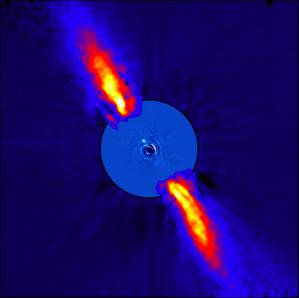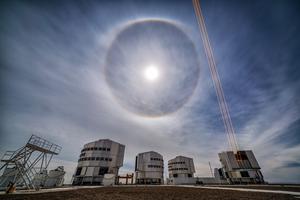Glossary term: Adaptive Optics
Description: When you look up at night, you might see the stars twinkle. The air in the atmosphere is always in motion, and as light from a star passes through a region with turbulence, it gets deflected by a varying amount. That is why what we can see in the sky is not a single steady point of light for each star, but a dancing, ever-changing, distorted succession of points. For astronomers, twinkling means that they cannot take images of celestial objects in as much detail as their large ground-based telescopes would otherwise allow. Adaptive optics is a way of mitigating that effect. Using either a real star or a laser-projected "artificial star", an adaptive optics ("AO") system monitors atmospheric distortion in real time. Light that has entered the telescope is guided onto a deformable mirror. Controlled by a computer, that mirror is continuously deformed in just the right way to counteract atmospheric distortion.
Related Terms:
See this term in other languages
Term and definition status: This term and its definition have been approved by a research astronomer and a teacher
The OAE Multilingual Glossary is a project of the IAU Office of Astronomy for Education (OAE) in collaboration with the IAU Office of Astronomy Outreach (OAO). The terms and definitions were chosen, written and reviewed by a collective effort from the OAE, the OAE Centers and Nodes, the OAE National Astronomy Education Coordinators (NAECs) and other volunteers. You can find a full list of credits here. All glossary terms and their definitions are released under a Creative Commons CC BY-4.0 license and should be credited to "IAU OAE".
If you notice a factual error in this glossary definition then please get in touch.
Related Media
beta Pictoris b
Credit: ESO/A.-M. Lagrange et al. credit link
License: CC-BY-4.0 Creative Commons Attribution 4.0 International (CC BY 4.0) icons
ESO's Very Large Telescope (VLT) at Paranal Observatory with a lunar halo
Credit: Juan Carlos Muñoz-Mateos/ESO credit link
License: CC-BY-4.0 Creative Commons Attribution 4.0 International (CC BY 4.0) icons










